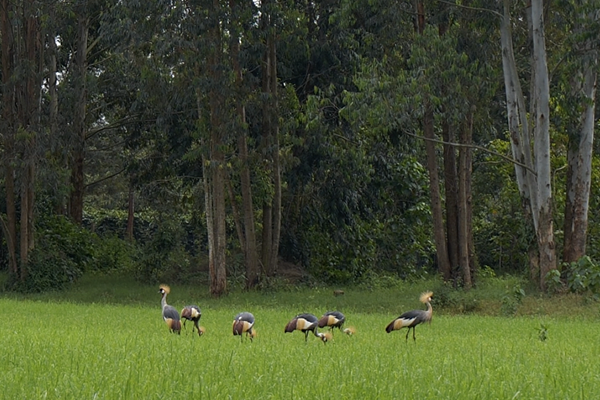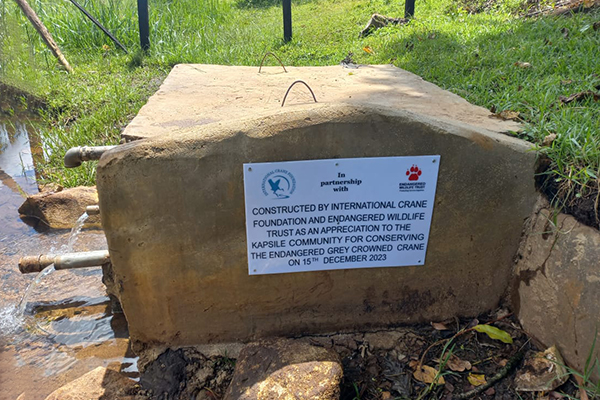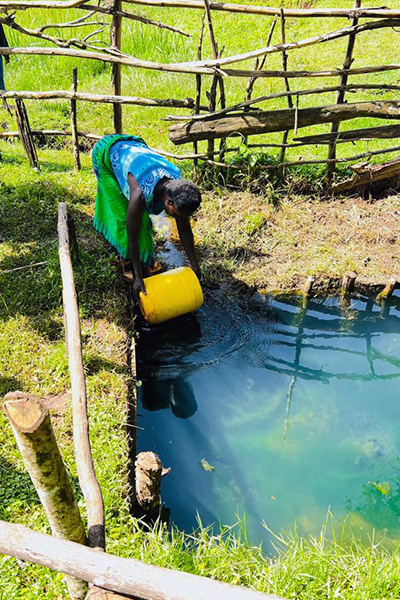CONTACT: Jodi Legge, Director of External Affairs, 608-356-9462, ext. 120
International Crane Foundation Installs Six Springs in Nandi County with More Needed
Aug. 29, 2024 (Kenya, Africa) – The International Crane Foundation installed six freshwater springs in Nandi County, Kenya, this year, providing more than 5,000 families with fresh water, thanks in part to a one-million-dollar commitment from the Leiden Conservation Foundation and the support from the local communities and governments. Families throughout Nandi County rely on water for domestic use and to care for their livestock, yet 54 percent of people in this county do not have access to safe water.

“We believe access to clean water is a fundamental human right,” said Eva Tokoi, Senior Field Officer for the International Crane Foundation in Kenya. “Yet, millions of people around the world lack this basic necessity.”
Tokoi noted many Nandi County residents, especially women and children, must travel miles from home into the wetland to collect water from open springs, sometimes having to sacrifice time in school to fetch the water needed. However, not only is this water unsafe to drink unless treated, but it also disturbs the wetland area, an important resource for the community and a feeding and breeding ground for the Endangered Grey Crowned Crane.
When looking for innovative ways to protect cranes, we always start by talking to the local communities. By working with the people that live there, as well as the local governments, together we can figure out the best way forward, combining community health and conservation efforts.”
Dr. Joseph Mwangi, Kenya Country Manager for the International Crane Foundation
The spring project involves collecting water from an eye of the spring and providing free access to the site to everyone that needs clean water. The eye of a spring is the point where water from an underground spring emerges at the surface of the ground. Springs can form when the water table, or the top level of groundwater, meets the surface. The water can flow out of a single hole or seep out along a line. Sites are selected based on their durability, the likelihood of the spring benefitting many people, acceptance and ownership from the local community, and the presence of Grey Crowned Cranes. The innovative design is cost-effective, low-maintenance, and is built for long-term sustainability.
Once the sites are selected, a community group is set up to manage the project using a phased approach. The group first sets goals, then helps with land siting, legal issues, and water quality tests. This involves building a filtration system as designed by the county water department with a simple mechanism to ensure the water is clean.

Before construction, the immediate area at the discharge is excavated and filled with rocks and gravel of different sizes to filter the water. A block wall is then constructed to hold the excavated area, after which a collecting water tank is built. Next, pipes are built. This includes the overflow pipes located near the top of the tank; a water fetching pipe located in the middle where community members can collect the water; and a washout pipe – located at the bottom of the tank (for use when washing the tank). This structure ensures surface flow does not enter the water tank to avoid contamination.

“This approach brings ownership and sustainability to each project,” said Tokoi.
Each site costs between $3,500 and $4,000 (U.S. dollars) for construction materials. The Foundation has the capacity to build 10 springs per year; however, the current budget only allows for two or three per year. “We would love to expand our ability as funding allows,” said Mwangi, “and we are always looking for donors willing to support our work in Kenya.”
The six springs already installed have provided clean water to families, schools, churches, hospitals, and shopping centers. With access to fresh water, the Foundation is reporting less disturbance in the wetlands and a higher percentage of crane habitat for breeding. The partnership has other community benefits as well – including less crane poisoning reported, community members caring for crane nesting sites, and overall improved tolerance to cranes throughout Nandi County.
“All species thrive when we work together,” said Mwangi.
Support the Foundation’s work in Kenya and throughout the world here.
The International Crane Foundation works worldwide to conserve cranes and the ecosystems, watersheds, and flyways on which they depend. We are a non-profit conservation organization established in 1973 and registered in the United States of America. We have knowledge, leadership, and inspiration to engage people in resolving threats to cranes and their diverse landscapes. From its 300-acre headquarters in Baraboo, Wisconsin, the Foundation reach extends across the globe, with offices and staff in China, Uganda, Kenya, Zambia, and South Africa, as well as Texas. It works through strong partnerships with local organizations, governments, universities, businesses, and others in these regions. More than 125 Foundation staff and partners work with a network of hundreds of specialists in 50 countries on five continents. The Foundation is committed to a future where all 15 of the world’s crane species are secure. Through the charisma of cranes, the International Crane Foundation envisions a future where people work together for wild crane populations and the landscapes they depend on – and by doing so, find new pathways to sustain our water, land, and livelihoods. Visit savingcranes.org for more information and to support our work.
Leiden Conservation Foundation was formed in 2011 by Tom and Kathy Leiden of Cleveland, Ohio. Their passion for nature started 30 years ago, when Tom became interested in birding in his hometown of Cleveland. His study of birds led him to appreciate the interconnections of nature and thus began a lifelong journey to help conserve our world’s wildlife. Their commitment has taken them across the United States, and to Africa and Asia. Tom serves as a board member for the International Crane Foundation and previously served on the Cleveland Zoological Society Board, the Cleveland Museum of Natural History Board, the Natural Areas Committee and the Giraffe Conservation Foundation USA Board. In 2014, Tom and Kathy received the Cleveland Museum of Natural History’s Conservation Award.
The Leidens believe working in the field with researchers and conservationists to save a species from going extinct in the wild puts a different perspective on the work required. From monitoring red-cockaded woodpecker nests to installing trackers on African penguins to assisting in the translocation of the Rothschild’s giraffe across the Nile River, all were tremendous learning experiences for them. It is about collaborating with people and their communities to develop a win-win situation for the people, the ecosystem and the wildlife present. Leiden Conservation Foundation has supported the International Crane Foundation and our work across the globe for nine years.
